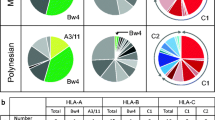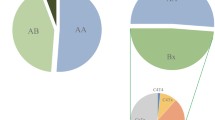Summary
This paper reports the distribution of immunoglobulin Gm and Km allotypes in 74 Chinese geographical populations. These populations are derived from 24 nationalities comprising 96.6% of the total population of China. A total of 9,560 individuals were phenotyped for Gm(1,2,3,5,21) factors, and 9,611 were phenotyped for Km(1). Phylogenetic trees were constructed on the basis of Gm haplotype frequencies and genetic distances. The results of cluster analysis show the heterogeneity of the Chinese nation, and confirm the hypothesis that the modern Chinese nation originated from two distinct populations, one population originating in the Yellow River valley and the other originating in the Yangtze River valley during early neolithic times (3,000–7,000 years ago). Frequencies of the Gm haplotype of 74 Chinese populations were compared with those of 33 populations from major racial groups. The results suggest that during human evolution, the Negroid group and Caucasoid-Mongoloid group diverged first, followed by a divergence between the Caucasoid and Mongoloid. Interrace divergence is high in comparison with intrarace divergence. There appear to be two distinct subgroups of Mongoloid, northern and southern Mongoloid. The northern and southern Mongoloid have Gm1;21 and Gm1,3;5 haplotypes as race-associate markers, respectively. Furthermore, the Caucasian-associated haplotype Gm3;5 was found in several of the minorities living in the northwest part of China. The presence of the Gm3;5 haplotype is attributed to the Caucasians living in Central Asia throughout the Silk Road. The amount of Caucasian admixture has been estimated. In contrast to the Gm haplotype distribution, Km1 gene frequencies showed a random distribution in the populations studied.
Similar content being viewed by others
References
Bernstein F (1931) Comitato Italiano per lo studio dei problemi della populazione. Istituto Pologratico dello Stato, Rome
Cann RL, Stoneking M, Wilson AC (1987) Mitochondrial DNA and human evolution. Nature 325:31–36
Cavalli-Sforza LL, Bodmer WF (1971) The genetics of human populations. Freeman, San Francisco
Cavalli-Sforza LL, Edwards AWF (1963) Analysis of human evolution. In: Geerts SJ (ed) Genetics today, vol 2. Pergamon Press, New York, pp 932–952
Chen D (1986) The taxonomy of neolithic man and its phylogenetic relationship to later paleolithic man and modern man. Acta Anthropologica Sinica 5:114–127
Chen YL (1987) National dictionary. Shanghai Book Press, Shanghai
Han K (1986) Anthropological characters of the human crania from Loulan site Xinjiang. Acta Anthropologica Sinica 5:227–242
Jian BZ (1983) Essentials of Chinese history. People Press, Beijing
Johnson WE, Kohn PH, Steinberg AG (1977) Population genetics of human allotypes Gm, Inv, and A2m. Clin Immunol Immunopathol 7:97–113
Lange G de, Fa-ming Z, Henke J, Feng Z, Bernhardt R, Leeuwen F van, Eede P van (1985) Immunoglobulin allotypes in a Chinese population: comparison of haplotype frequencies with other Asian groups. J Immunogenet 12:191–195
Lee TD, Zhao TM, Mickey R, Sun YP, Lee G, Song CX, Cheng DZ, Zhou MS, Ding SQ, Cheng DX, Song FJ, Lee PY, An JB, Mittal KK (1988) The polymorphism of HLA antigens in the Chinese. Tissue Antigens 32:188–208
Lin S (1987) Trends of distribution of early man in China. Acta Anthropologica Sinica 6:190–195
Loghem E van (1978) Genetic studies of human immunoglobulins. In: Weir DM (ed) Handbook of experimental immunology. Blackwell, Oxford, pp 11.1–11.15
Loghem E van (1984) Genetic markers of immunoglobulins. In: Engelfriet CP, Loghem IJ van, Borne AEGK von dem (eds) Immunohaematology. Elsevier, Amsterdam, pp 58–71
Matsumoto H, Miyazaki T, Ishida N, Katayama K (1982) Mongoloid populations from the viewpoints of Gm patterns. Jinrui Idengaku Zasshi 27:271–282
Nei M (1972) Genetic distance between populations. Am Naturalist 106:283–292
Piazza A, Sgaramella-Zonta L, Gluckman P, Cavalli-Sforza LL (1975) The Fifth Histocompatibility Workshop Gene Frequency Data: a phylogenetic analysis. Tissue Antigens 5:445–463
Sneath PHA, Sokal RR (1973) Numerical taxonomy, the principle and practice of numerical classification. Freeman, San Francisco, pp 201–213
State Statistical Bureau of the People's Republic of China (1982) Communique of the major figures of the 1982 populations census. China Daily, October 28, p 4
Steinberg AG, Cook DE (1981) The distribution of human immunoglobulin allotypes. Oxford University Press, London
Stringer CB, Andrews P (1988) Genetic and fossil evidence for the origin of modern humans. Science 239:1263–1268
Wainscoat JS, Hill AVS, Boyce AL, Flint J, Hernandez M, Thein SL, Old JM, Lynch JR, Faluis AG, Weatherall DJ, Clegg JB (1986) Evolutionary relationship of human populations from an analysis of nuclear DNA polymorphisms. Nature 319:491–493
Wang L (1986) Secular change and geographical variation in Chinese neolithic and modern inhabitants. Acta Anthropologica Sinica 5: 243–258
WHO Meeting on Human Immunoglobulin Allotypic Markers (1976) Review of the notation for the allotypic and related markers of human immunoglobins. J Immunogenet 3:357–362
Williams RC, Steinberg AG, Gershowitz H, Bennett PH, Knowler WC, Pettitt DJ, Butler W, Baird R, Dowda-Rea L, Burch TA, Morse HG, Smith CG (1985) Gm allotypes in Native Americans: evidence for three distinct migrations across the Bering Land Bridge. Am J Phys Anthropol 66:1–19
Wu X, Zhang Z (1985) Homo sapiens remains from late palaeolithic and neolithic China. In: Wu R, Olsen JW (eds) Palaeoanthropolgy and palaeolithic archaeology in the People's Republic of China. Academic Press, Orlando, Fla, pp 107–133
Zhang Z (1985) The physical characters of Zang (Tibetan) nationality. Acta Arthropologica Sinica 4:250–258
Zhao TM (1987) Human blood group genetics. Science Press, Beijing, pp 365–371
Zhao TM, Zhang GL, Liu DZ, Chen ZY, Zhang LX (1983) The distribution of human immunoglobulin Gm, Km factors in Han nationality and Uighurs. Acta Genetica Sinica 10:311–316
Zhao TM, Zhang GL, Yuan YD, Du RF (1984) Genetic distances estimated on the basis of HLA. Acta Anthropologica Sinica 3:165–170
Zhao TM, Zhang GL, Bu KJ, Zheng SQ, Gu W (1985) Immunoglobulin Gm and Km allotypes in Chinese (Han): a family study. Acta Genetica Sinica 12:149–153
Zhao TM, Zhang GL, Zhu YM, Zhen SQ, Liu DY, Chen Q, Zhang X (1987) The distribution of immunoglobulin Gm allotypes in forty Chinese populations. Acta Anthropologica Sinica 6:1–9
Author information
Authors and Affiliations
Rights and permissions
About this article
Cite this article
Zhao, T., Dao Lee, T. Gm and Km allotypes in 74 Chinese populations: a hypothesis of the origin of the Chinese nation. Hum Genet 83, 101–110 (1989). https://doi.org/10.1007/BF00286699
Received:
Revised:
Issue Date:
DOI: https://doi.org/10.1007/BF00286699




